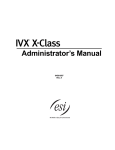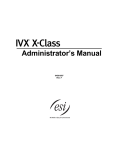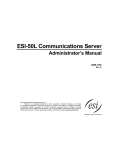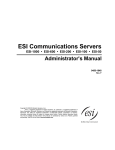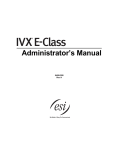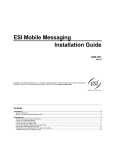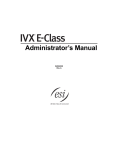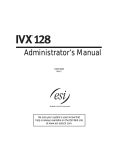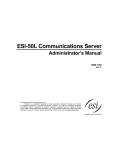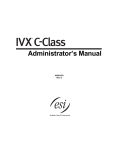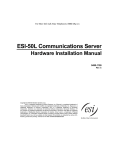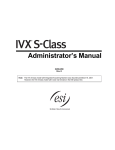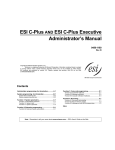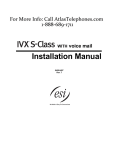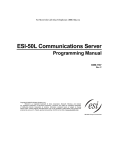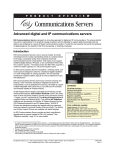Download ESI IVX E-Class User`s guide
Transcript
Administrator’s Manual 0450-0381 Rev. D About ESI ESI (Estech Systems, Inc.) is a privately held corporation based in Plano, Texas. Founded in 1987, ESI designs and builds innovative telecommunications products for businesses like yours. Because of their powerful combination of value and features, ESI products are consistently recognized by industry publications and leaders. Copyright © 2004 ESI (Estech Systems, Inc.). IVX is a registered trademark of ESI. Microsoft, Windows, and Outlook are registered trademarks of Microsoft Corporation. Panasonic and DBS are registered trademarks of Matsushita Electric Corporation of America. Information contained herein is subject to change without notice. ESI products are protected by U.S. Patents No. 6,067,349 and 6,252,944, and others pending. ESI is an ISO 9001-certified company. Visit ESI on the Web at www.esi-estech.com. . Table of contents Administrator programming: An introduction ............................................................................................A.1 Administrator’s duties...................................................................................................................................................................................A.1 Telephone system features .........................................................................................................................................................................A.1 Voice mail features .......................................................................................................................................................................................A.3 ACD features ................................................................................................................................................................................................A.3 Feature Phone overlays ..............................................................................................................................................................................A.3 Programming basics....................................................................................................................................................................................A.4 System programming overview ..................................................................................................................................................................A.4 Programming keys .......................................................................................................................................................................................A.5 Entering alphanumeric characters..............................................................................................................................................................A.5 System fixed numbering plan......................................................................................................................................................................A.6 Remote setting of day, night, holiday and auto modes .............................................................................................................................A.6 Function 1: System parameters..................................................................................................................B.1 Function 13: Administrator password........................................................................................................................................................B.1 Function 14: System clock ..........................................................................................................................................................................B.1 Function 17: System speed-dial..................................................................................................................................................................B.3 Function 3: Extension programming ..........................................................................................................C.1 Function 32: Extension feature authorization.............................................................................................................................................C.1 Function 5: Voice mail programming..........................................................................................................D.1 Function 53: Guest/info mailboxes .............................................................................................................................................................D.1 Function 54: Group mailboxes and the broadcast mailbox......................................................................................................................D.2 Function 55: Message notification ..............................................................................................................................................................D.3 Function 56: Cascade paging mailboxes ...................................................................................................................................................D.4 Function 57: Q & A mailboxes .....................................................................................................................................................................D.5 Function 6: Recording ................................................................................................................................E.1 Function 61: Re-record system and auto attendant branch prompts ......................................................................................................E.1 Function 62: Record directory names ........................................................................................................................................................E.2 Function 63: Message-on-hold (MOH) programming...............................................................................................................................E.3 Function 7: Reports .................................................................................................................................... F.1 Report printing ...............................................................................................................................................................................................F.1 Reporting functions .......................................................................................................................................................................................F.1 Feature description: SMDR.........................................................................................................................G.1 Tabular SMDR format ..................................................................................................................................................................................G.1 CSV SMDR format.......................................................................................................................................................................................G.1 Reporting conventions and rules ................................................................................................................................................................G.2 Index (This page included for pagination purposes only.) IP E-Class Administrator’s Manual Administrator programming: An introduction Administrator programming: An introduction You can program ESI’s IP E-Class system (IP 200e or IP 40e) locally or remotely from a 48-Key IP Feature Phone while the system is operating. You also can program using ESI’s Esi-Admin, a Windows-based software application your ESI Reseller can provide. Read the E-Class User’s Guide first. Programming features require a clear understanding of user interface and application. Administrator’s duties The System Administrator can perform the following tasks: • Administering station assignments • Managing station feature authorization • Maintaining the employee directory (if it’s used) • Re-recording system prompts • Administering manual change of Day/Night mode (if required) User assistance Each ESI phone system’s Verbal User Guide includes all of the information printed in the User’s Guide (except for special features). Additionally, the ESI system users’ Web site, www.esiusers.com, includes all the information in the User’s Guide, and more. Telephone system features The IP E-Class PBXs support a comprehensive array of robust features, including: • IP Feature Phone – Compact and rugged design includes a high-quality speakerphone, large and informative multi-functional display, and a specially designed key layout with several dedicated keys to minimize or eliminate the need to memorize codes. The IP phone is TAPI-compliant, and a TAPI driver is available as a free download from the ESI Web site. ™ • Extensive help – Verbal User Guide uses spoken and displayed help prompts to assist everyone from the installer through the administrator down to the least experienced end user. Easily accessible with one press of the HELP key. • Enhanced Caller ID – Allows one-touch automatic message return. • Live call recording — Can record any conversation or personal memo, with moving or copying of any recording to another user’s voice mailbox (see “Voice mail features,” page A.3). • Call waiting — Includes helpful display, showing both calls’ Caller ID information, and easy one-key toggling between calls. • Conference calling — Includes 24 conference bridges, and a conference may contain up to four parties, so the IP E-Class systems can support six conferences of four parties each or eight conferences of three parties each. ™ • Esi-Dex speed-dialing — Calls any number from any of the three separate lists (personal, station, and system); uses Caller ID information or direct keypad entries. • Dedicated overhead paging interface — Allows overhead paging through the user’s own overhead paging system. A.1 Administrator programming: An introduction IP E-Class Administrator’s Manual • Intelligent call forwarding — Lets users of compatible PRI-equipped ESI systems view the original Caller ID data of a call forwarded to an off-premises phone. Important: See the Intelligent Call Forwarding Feature Overview (0450-0674) for more details. • 911 alert — Provides immediate line access if any station dials 9 1 1 to report an emergency; sends a message via the serial port indicating the start date, time, station number and end-time of the 911; also sounds a warning tone at the operator station and displays (for example): 911 CALL FROM X102 JOHN JAMES • Status indicator lamp — Indicates three conditions of the IP Feature Phone (local or Remote): off-hook, ringing and new voice mail message. • Optional NSP (Network Services Processor) — Allows system programming via TCP/IP. Comes in four formats that can be adapted to fit a variety of phone system configurations, small to large. • Optional unified message notification — Provides an optional, value-added interface to an NSP-enabled IP E-Class system. Delivers voice mail notification to Microsoft® Outlook® 2000/2002. Remote network features (VoIP) In addition to a robust set of telephony features, the IP E-Class PBXs have the capability for extending PBX operation to any location that has access to a suitable high-speed data connection. This capability is provided with the Remote IP Feature Phone and Esi-Link. • Remote IP Feature Phone — Ideal for the remote site installation requiring one, or no more than a few, extensions. Once installed, the remote user is provided a near identical capability and connectivity of the phone user in the main office. Numerous remote sites can be supported from a single IP PBX. Refer to the Remote IP Feature Phone Product Overview and the E-Class User’s Guide for more information. • Esi-Link support — Provides the capability of connecting up to 100 IP PBXs at different locations into a single private phone system. The ESI IP PBX features that, without Esi-Link, are available to just a single location can now be extended across several locations, greatly enhancing the integration opportunities of a business with multiple locations. Refer to the Esi-Link Product Overview for a full explanation of Esi-Link capabilities. A.2 IP E-Class Administrator’s Manual Administrator programming: An introduction Voice mail features • Nine message-on-hold sources — Among these are three prerecorded tracks and five customerrecordable tracks; also supports live input. • Message Recycle Bin (undelete) — Remembers, and can restore, each mailbox’s 10 most recently deleted messages ™ • Quick Groups — Makes it easy to leave voice mail messages for several users. • Quick Move™— Allows recording conversations or calls directly into a designated mailbox. • Virtual Mailbox Key™ — Allows easy monitoring of a second mailbox. ACD features • Routes calls within designated departments for quickest possible call answering. • Uses IP Feature Phone display to provide up-to-the-second information on queues and wait times. • Sends calls to longest-idle agent. Feature Phone overlays Each ESI Feature Phone comes with one overlay for the programmable feature keys. To order additional overlays, visit the DESI™ Web site at www.desi.com. You can also download the free Windows®based software, DESI Lite, which allows you to print on the overlays. For assistance with DESI products, please consult the DESI Web site. Tip: Remember that ESI’s Esi-Access software, available from www.esiresellers.com, also lets you print on the overlays as well as perform many other programming tasks. A.3 Administrator programming: An introduction IP E-Class Administrator’s Manual Programming basics As mentioned earlier, you may program from any IP Feature Phone in the system: 1. Press PROGRAM. The normal station programming menu prompt will begin to play. Press HOLD to stop the prompt. 1 2. Enter the Administrator password , followed by #. You are now in programming mode (during this time, the extension will be automatically placed in DND). 3. Follow the system programming menu to program as you wish; and, when finished, hang up. Note: The system will automatically exit programming mode after 10 minutes of inactivity. Example: If your Administrator password is 864, enter programming mode by pressing PROGRAM HOLD 8 6 4 # (To exit programming mode, hang up.) System programming overview Once you’ve accessed programming mode on an IP Feature Phone, the system will prompt for — and confirm — each keystroke action via voice commands and the display. You program both configuration data and recordings in the same manner. The following menu shows Administrator programming functions available on the IP E-Class system: 1 System parameters 13 Administrator password 14 System clock 141 Set time/date 142 Automatic time setting 17 System speed dial 3 Extension programming 32 Extension feature authorization 5 Voice mail programming 53 Guest/info mailboxes 54 Group mailboxes 55 Message notification options 551 Station delivery options 552 Delivery/paging parameters 56 Cascade paging mailboxes 57 Q & A mailboxes 1 Default is 4 5 6. A.4 6 Recording 61 Record system prompts 62 Record directory names 63 MOH programming 631 MOH source 632 Record MOH 633 MOH volume 7 Reports 73 ACD department report 74 Voice mail statistics report 75 System speed-dial list IP E-Class Administrator’s Manual Administrator programming: An introduction Programming keys During programming, the first line of the display will show the current item being programmed, and the second line will be the entry line. You can enter values as directed by the combination of the voice prompts and display. To enter multiple values, such as a list of extension numbers, separate each value by # (to exit the list, enter # #). To... Press ... Enter # Back up (i.e., reverse direction) Delete Exit Help Select/scroll ½ HOLD [Hang up] HELP W (left-side scroll key) V (right-side scroll key) What this does Confirms new or existing entry and advances to next programming step. Backs up to previous prompt without changing its value. Deletes data or recording. Exits programming mode and removes extension from DND. Provides more detailed instructions during programming. • During entry of a value, backs up. • If a list is present (“>” is displayed), scrolls to left. • Selects from options presented. • If a list is present (“>” is displayed), scrolls to right. • Inserts a space during entry of a name. Note: Either < or > in the display indicates that additional choices or values are available by pressing a corresponding scroll key (Wor V). Entering alphanumeric characters You enter names for extensions and departments by pressing the dial pad key that corresponds to the character to be entered. The key’s possible entries will change each time the key is pressed, and the display will show this. When the desired character appears on the display, press # to confirm; the cursor will move to the next character position. You may move the cursor left (to correct an entry) by pressing the left scroll key (W) or move right (to add a space) by pressing the right scroll key (V). Key 0 1 2 3 Options 0, - (hyphen), _ (underline) Q, Z, 1, “_” (space) A, B, C, 2 D, E, F, 3 4 G, H, I, 4 5 6 J, K, L, 5 M, N, O, 6 Key 7 8 9 W (left scroll key) V (right scroll key) # ## Options P, R, S, 7 T, U, V, 8 W, X,Y, 9 Backs up and erases Adds a space [Enter] Ends the name Example: To enter a B, press 2 twice (the possible options to scroll through are A, B, C and 2). When B is displayed, press # to confirm; the cursor will move to the next character to be entered. To complete the name, press # #. A.5 Administrator programming: An introduction IP E-Class Administrator’s Manual System fixed numbering plan Numbers 0 1–66 100–195 199 200–229 290–299 300–489 490–499 500 Function Operator CO lines User extensions Overhead paging port Analog ports Department numbers Guest/info mailboxes Q & A mailboxes Broadcast mailbox Numbers 501–516 520–529 530–550 560–589 590–598 600–699 700–799 988 Function Group mailboxes Cascade paging mailboxes Recordable system prompts Feature codes MOH recordings System speed dial Esi-Link locations Modem Remote setting of day, night, holiday and auto modes Normally, the system’s day/night mode operation will be manually controlled at an ESI Feature Phone and/or set to follow the day/night mode tables (programmed by the Installer) automatically. In addition, the Administrator can remotely change the mode and/or re-record the holiday greeting to handle unexpected closings such as for inclement weather. Remotely logging into the system with the Administrator password lets the caller re-record the ID 1 greetings (day, night, day2 and night2) and the holiday greeting, as well as change the mode to day/night/holiday/day2/night2 (or auto). 1. At the main greeting, enter ½ ½ 4 5 6 # — or ½ ½ [the new password] # — to enter remote programming mode. 2. You’ll hear prompts that will allow you to change the answer mode (day, night, day2, night2, holiday or auto) and/or to re-record the holiday greeting and the main greeting (ID 1). Follow the prompts to perform the desired operation. 3. Exit by pressing ½ and hanging up. Prompts for remote settings: an outline 1 Set answer mode 1 2 3 4 5 6 Day mode Night mode Holiday mode Use day/night table* Day2 mode Night2 mode 2 Record holiday main greeting 3 Record daytime main greeting 4 Record nighttime main greeting 5 Record day2 main greeting 6 Record night2 main greeting Note: If the system is answered live and call is then routed to a mailbox., the Administrator can press 8 to return to the main greeting and then follow the steps for making remote settings. * This is used if the Installer has programmed an automatic calendar. A.6 IP E-Class Administrator’s Manual Function 1: System parameters Function 1: System parameters Function 13: Administrator password These functions will display the existing password and prompt for entry of a new password. The passwords can be 2–8 digits long, followed by #. The Installer can change either the Installer or Administrator password. Only those functions listed in the Administrator Manual can be programmed via the Administrator password. The default Administrator password is 4 5 6. Notes: You can use the Administrator password to access a user’s station programming. At the station, when prompted for the user’s password, enter either the Administrator password, then follow normal user programming procedures. Accessing user station programming Should a user forget his password or if an employee leaves the organization, this feature allows the Installer or Administrator to enter a user's station programming and operate within it as if he were the user. From the user’s station, enter the Administrator password when the system prompts for the user password. Example: From station 105, entering 4 5 6 # instead of the user password (1 0 5 #) will enter the station’s user programming. (Default password shown for this example). Function 14: System clock Function 141: Set time/date 1. Enter a new time in a twelve-hour format. Example: Enter 1 2 3 3 for 12:33, or 3 1 5 for 3:15 (note that you need no leading zero for the time). 2. Select AM or PM by pressing a scroll key (either W or V). 3. Enter a new date in an eight-digit format, including leading zeroes. Example: Enter 0 7 0 4 2 0 0 3 for July 4, 2003 (note that leading zeroes are required here, unlike in Step 1). 4. Press # to finish the entry. Note: A built-in battery maintains the correct time and date, even in the event of a power loss. B.1 Function 1: System parameters IP E-Class Administrator’s Manual Function 142: Automatic time setting 1. Synchronize with CID This function, when enabled, synchronizes the real-time clock with Caller ID (CID) messaging: call processing compares the time of a CID message to the system real-time clock and, if the difference is more than two minutes, resets the real-time clock to match the time (hours and minutes) of the CID message. The system will analyze each such message (or — if it receives more than four calls with CID information within a one-minute period — as is needed). Select ENABLE or DISABLE by pressing a scroll key (either W or V). Choosing ENABLE will allow the CID data to update the time and date. Default: Enabled. Notes: If this function is enabled, Esi-Link time synchronization (from location 700) will be disabled. If this function is disabled, Esi-Link time synchronization will be allowed (minutes only). 2. Adjust for Daylight Savings Time This function, when enabled, causes the real-time clock to adjust itself automatically for Daylight Savings Time (DST). Select AUTO or DISABLE for DST by pressing a scroll key (either W or V). Choosing DISABLE is best for those areas that don’t observe DST. Default: Disabled. Note: If this function is enabled and it causes an automatic time change, the system won’t update the real-time clock from either Caller ID messages (Function 1421, above) or Esi-Link time synchronization for 25 hours before and 25 hours after the time change is due to be effective (i.e., 2:00 AM Sunday). B.2 IP E-Class Administrator’s Manual Function 1: System parameters Function 17: System speed-dial Up to 100 system speed dial names and associated numbers can be stored, in location numbers 600–699, for access by any station. A user can initiate a system speed-dial by dialing the speed dial location number or by accessing the name through the Esi-Dex feature. In Function 32, access to system speed-dial can be denied to individual stations (see page C.1). Note: System speed-dialing overrides toll restrictions (Function 32, page C.1). 1. Enter the 3-digit location number to program, 2. Enter a ten-character name (see “Entering alphanumeric characters,” page A.5). 3. Enter the number to be dialed (including the line group 9, 8, or 71–76). Press the left scroll key (W) to backspace and delete any character or digit entered in error. Here’s an example: 1. Speed-dial number 601 2. Name AUTO RENTL 3. Number 915552221212 The number dialed in Step 3 can be up to 30 digits long including the following special codes: Code # ½ F P What it produces # DTMF tone ½ DTMF tone Flash hook 2-second pause To insert a special code, press the right scroll key (V) to select the desired special code: # , ½ , F or P. Press # to confirm the inserted character and continue. Press # # to complete the entry. Example: To create a System Speed Dial number that dials 9, then 972-555-5644, then pauses for four seconds and finally dials #104, enter: 9 9 7 2 5 5 5 5 6 4 4 (then scroll to) P # (then scroll to) P # (then scroll to) # # 1 0 4 # Deleting a speed dial number To delete an entire speed dial number and name, delete the location number (6 X X) by pressing HOLD or the left scroll key (W) during Step 1 in the speed-dialing procedure described above. B.3 Function 1: System parameters IP E-Class Administrator’s Manual (This page included for pagination purposes only.) B.4 IP E-Class Administrator’s Manual Function 3: Extension programming Function 3: Extension programming Important: Where any gray shading (■) appears in an example, it represents values either unavailable to the function or unused in the particular example. Function 32: Extension feature authorization An Administrator can allow or deny many extension features on an extension-by-extension basis. A User, however, can only program and use allowed features (by using a combination of voice and display prompts) from his/her phone. Below is an example of a completed Programming Worksheet. The programming sequence is: 1. 2. Ext. Name 3. Call wait XXX 100 101 102 110* Default Jane Roger Sally Bill Y Y Y Y Y 4. DND Y Y Y Y 5. AA block N N N N N 6. Rec. 7. Svc. obs. 8. Toll allow Y Y Y N N N N N Y Y Y Y Y 9. 10. Sys. Auto spd. dial Page Y Y Y Y Y N Y N Y N 11. Ext. fwdg. N N N N N 12. 13. 14. Fwdg. to Trk-to-trk Unified toll nos. xfer msgg. N N N N N N N N N N N N N N The programming steps are: 1. Extension number — Enter the extension number to program. 2. Extension name — Name the extension (if it hasn’t previously been named by the Installer). For each of the following features, press a scroll key (W or V) to select YES or NO. 3. Call waiting — Allows the user to turn call waiting on or off for his station. 4. Do not disturb — Allows the user to activate DND from his station. 5. Auto attendant block — Blocks calls from being transferred to the station from the auto attendant; follows the extension’s call forward day/night as programmed by the Installer. 6. Live recording feature — If enabled, will allow the user to record conversations. 7. Service observing — Allows the user to monitor the conversations of those stations listed in the service observing list for his/her station. If this is enabled, you must enter a list of allowed extensions. Note: A Department number can be entered as an extension in the Service Observing list and will then automatically include all members of the Department even if the members of the Department are later changed. 8. Toll restriction — “YES” allows the user to place toll calls. If you select “NO,” the user can make only either non-toll calls or calls to numbers listed in the allow exception table. 9. System speed dial — “YES” allows the user to access and place system speed dial calls. (Continued) * An example of an analog phone. C.1 Function 3: Extension programming IP E-Class Administrator’s Manual 10. AutoPage — Lets the user turn AutoPage (defined below) on or off at his/her station. Note: This feature is used in conjunction with the directory names recorded in Function 62 and is not active until a directory name is recorded for the extension. If the station user has his/her mailbox set to answer with personal greeting 3 and a caller presses 3 to page that user, this feature automatically pages the station user in the page zones entered in Function 31. If no page zone is entered, all ESI Feature Phones on the system are paged. Default: Disabled. Note: When AutoPage is enabled, the IP E-Class system will use the last installed idle digital port to perform the page. Therefore, if a phone is on the last installed port, the phone’s user may experience a brief delay in telephone operation if he/she picks up the handset (or presses SPEAKER) during the AutoPage. 11. External forwarding — Allows the station user to use the call forwarding/off-premises and offpremises “reach-me” features. See the User’s Guide for more information about these features. Default: Enabled. Note: After the system dials the external forwarding number, it will play a prompt saying, “You are receiving a forwarded call. Press any key to accept.” This prompt will play continuously for 30 seconds. If the forwarded call is answered and the called person dials a digit, the forwarded call will be connected to that person. If no digit is dialed, the caller is automatically forwarded to voice mail. While the two lines (trunks) are connected, the system constantly monitors the line for open loop conditions (hang-up). If an open loop is detected on either line, the call is disconnected. The system also monitors for voice activity on the connected lines; if voice is no longer detected, the call is disconnected. Finally, if both lines are connected for more than 60 minutes1, the call will be disconnected. 12. Forwarding to toll numbers — This feature is used in conjunction with external forwarding (see previous item). When enabled, this feature lets the user program a long-distance number for external forwarding. Default: Disabled. (Continued) 1 Default timer setting. To adjust this, contact ESI Technical Support. C.2 IP E-Class Administrator’s Manual Function 3: Extension programming 13. Trunk-to-trunk transfer — When enabled, this lets the station user initiate a trunk-to-trunk transfer. The user, while connected to a CO line, can press TRANSFER, dial an off-site number and then complete the trunk-to-trunk transfer by simply hanging up. Both outside parties are then connected. Default: Disabled. Important: USE OF FEATURES, SUCH AS TRUNK-TO-TRUNK TRANSFER, THAT REQUIRE TRUNK-TO-TRUNK CONNECTIONS WILL INCREASE THE RISK OF TOLL FRAUD. IN NO EVENT SHALL ESI (ESTECH SYSTEMS, INC.) BE LIABLE FOR ANY DIRECT, INDIRECT, INCIDENTAL OR CONSEQUENTIAL DAMAGES WHATSOEVER INCLUDING, BUT NOT LIMITED TO, FRAUDULENT TOLL CHARGES, LOSS OF BUSINESS PROFITS, BUSINESS INTERRUPTIONS OR ANY OTHER COSTS OR DAMAGES RELATED THERETO ARISING FROM THE USE OF THESE FEATURES. 14. Unified messaging — [The Installer should refer to “VIP programming” in the Network Services Processor Installation Manual (ESI document 0450-0439).] Example: Here is a portion of a completed Programming Worksheet for extension feature authori- zation. Note that: • Extension 100 cannot record calls but can make toll calls (except those listed in the deny table) and can access the system speed dial numbers. • In comparison, Extension 102 cannot make general toll calls but also can call any system speed dial number, even if it’s a toll call. • (Extension 112 doesn’t have DND, AA block, record or service observing capability because it’s an analog port.) 1. Ext. 2. Name 3. Call wait 4. DND 5. AA block 6. Rec. 7. 8. Svc. Toll obsv. allow 9. Sys. spd. dial 10. AutoPage 11. Ext. fwdg. 12. Fwdg. to toll nos. 13. Trk-totrk xfer 14. Unified msg. 100 Jane Y Y N N N Y Y N N N N N 102 Sally Y Y N Y N N Y Y N N N N 112* Bill Y Y Y N N N N N * An example of an analog phone. C.3 Function 3: Extension programming IP E-Class Administrator’s Manual (This page included for pagination purposes only.) C.4 IP E-Class Administrator’s Manual Function 5: Voice mail programming Function 5: Voice mail programming To simplify initial installation, all programmed extensions will automatically have the generic personal greeting, “You have reached the mailbox for extension [xxx].” The mailbox user should replace this with a personalized greeting. Each guest/info, group, cascade paging or Q & A mailbox must have a greeting recorded for the IP E-Class system to consider the mailbox active. Important: A mailbox will not receive broadcast messages until a greeting has been recorded for it. Additionally: if the default greeting is deleted, the mailbox will be considered inactive. Function 53: Guest/info mailboxes Mailboxes numbered 300–489 can be programmed as either a guest or info mailbox. Enter the mailbox number and select Guest or Info by pressing a scroll (W or V) key. Guest mailboxes Guest mailboxes are designed to be used by personnel, such as in outside sales or manufacturing, who do not have an extension assigned to them. A guest mailbox requires no programming other than the assigning of a name. Note: A guest mailbox can be handled like a regular extension (i.e., listed in the directory, assigned a station key, etc.), and is password-protected by default. If a programmable feature key is programmed as a virtual mailbox key with a guest mailbox number, the 1 key’s LED will blink, to indicate that new messages exist. To retrieve messages from a station, press VOICEMAIL ½ and then either press the DSS key or enter the mailbox number. To record a greeting, press PROGRAM ½ and the mailbox number; then press # to confirm, and follow the prompts. The default password is the mailbox number. To retrieve messages from the outside, press ½ and the mailbox number during the Main Greeting. Default: 300–489 as Guest. Info mailboxes Info mailboxes can be used to give callers information on a variety of different subjects by “publishing” these mailbox numbers. Info Mailboxes are identical to Guest Mailboxes except that the caller will not be given a record tone after the personal greeting (the information to be played). Instead, the caller will be forwarded as programmed in this function (default is the caller will be disconnected after the information is played). The maximum length of the record time is 14 minutes. Guest/info mailboxes are created or deleted here, but are turned “on” only when a personal greeting (the information to be played) has been recorded. Deleting the personal greetings will turn “off” the mailbox. To record a greeting, press PROGRAM ½ and the mailbox number; then press # to confirm, and follow the prompts. The default password is the mailbox number. Below is an example of a completed Programming Worksheet, showing the sequence of programming: 1. MB 400 402 1 2. Name Dana Literature 3. Type Guest Info 4. CF day 5. CF night MB 302 MB 302 Otherwise, the key is a DSS key that allows for single-key transfer of a call with no message indication. D.1 Function 5: Voice mail programming IP E-Class Administrator’s Manual Each programming step is defined as follows: 1. Mailbox number — Enter a mailbox number, 300–489. 2. Name — The mailbox name is used for the display, reports, and as a programming aid. The name length can be no longer than 10 characters (see “Entering alphanumeric characters,” page A.5). Default: The Mailbox number. 3. Type — Select a mailbox type: Guest or Info. Default: Guest. 4. and 5. Call forward (info mailbox only) — An info mailbox can be set to call forward after the personal greeting has played to an extension, department, a mailbox or a branch ID for day mode and differently for night mode. Default: ID9999 (automatic disconnect). Function 54: Group mailboxes and the broadcast mailbox Broadcast mailbox Mailbox 500, the broadcast mailbox, is a special group mailbox which can be used to leave messages for all of the system’s station users (extensions 100–183) who have recorded a personal greeting. The broadcast mailbox’s user list cannot be edited. Guest mailboxes are not included in the broadcast group. Group mailboxes You can assign up to 16 group mailboxes (501–516) to the IP E-Class system; each group mailbox can 1 have up to 32 members. Anyone who knows the password can leave messages for all users listed as members of that group and who have recorded a personal greeting. The Installer, Administrator or group mailbox “owner(s)” may set or change the list of Group Mailbox members. To record a greeting, press PROGRAM ½ and the mailbox number; then press # to confirm, and follow the prompts. The default password is the mailbox number. Important: A group mailbox is turned “on” (able to record and playback messages) only when its “owner” has recorded a greeting for it, such as “This is the group mailbox for East Coast Regional Sales.” Similarly, deleting the group mailbox greeting will turn “off” the group mailbox; any outstanding messages will remain in its members’ mailboxes until erased by each member. Notes: If 0 (zero) is programmed as the password, anyone can leave group messages or program the Group Mailbox. If a user saves a group message, it will be saved as a new message. 1. MB 501 2. Group member mailboxes’ numbers 102 104 106 107 122 303 314 Here is the programming sequence: 1. Enter the group mailbox number — Range: 501–516. 2. Enter group member mailboxes’ numbers — Separate each by #; enter # # to end the list. Range: User mailboxes (100–183) and guest mailboxes (300–489). 1 Although it cannot be in the broadcast group, a guest mailbox can be a member of any other group mailbox. D.2 IP E-Class Administrator’s Manual Function 5: Voice mail programming Function 55: Message notification On a mailbox-by-mailbox basis for user or guest mailboxes, the system can be programmed to call an off-premises number or another extension to deliver messages and/or dial to an external commercial paging network to activate a user's pager. The IP E-Class system will call and/or page when the first new message has been left in a mailbox and will repeat (at the interval of minutes programmed in this function) until the new message(s) have been deleted, saved or moved. The user can program the numbers and delay and can also select to have only messages marked as urgent delivered. The Installer and Administrator can set, on an individual-station basis: • The number to be called • A delay period • The number of attempts (maximum of 99) • The interval between attempts • A “quiet period" to suspend phone delivery — e.g., late at night (the quiet period is an on-and-off time that applies to all days of the week) Function 551: Station delivery options Programming of the station options, as shown below, can be performed by the Installer or Administrator. In addition, the user can change his phone number and pager number (but not phone or pager delay time). The phone number’s maximum length is 24 digits. 1. Phone 2. Pager 1. Number 9725556789 9725551234 2. Delay 30 0 3. Attempts 6 10 4. Interval 60 30 5. Quiet on 10:30PM 6. Quiet off 7:15AM To program, enter the extension number to program and select phone or pager to program. Then, enter: 1. Phone/pager number — The number to be dialed (without the CO line Group [9, 8 or 71–76). 2. Delay — How many minutes the system is to wait before dialing the phone or pager number. This allows the user to pick up a message if he is in the office. Range: 0–500. Default: 0. 3. Attempts — How many times that the system will call/page. Range: 0–99. (0 turns off delivery.) Default: 3. 4. Interval — How many minutes should elapse between attempts. Range: 10–1440. Default: 30. 5. Quiet period on — When the quiet period should begin. Default: (None.) 6. Quiet period off — When the quiet period should end. Default: (None.) Use the V scroll key to enter special characters; use the W scroll key to backspace. Press # to confirm the inserted character and continue. Press # # to complete the entry. D.3 Function 5: Voice mail programming IP E-Class Administrator’s Manual Function 552: Delivery/paging parameters The sequence of programming is as follows: 1. CO line access — Enter the CO line group (9, 8, or 71–76) that is to be accessed for delivery. Default: 9. 2. Maximum lines — Enter the maximum number of lines (in the selected CO line group) that the system can access simultaneously. Make enough lines available to accommodate high notification traffic (but be careful: if you make available all lines in the selected line group and high notification traffic occurs, the system could tie up all lines). Range: 1–19. Default: 1. 3. Pager dialing pause — When paging, the IP E-Class system will send the mailbox number to be shown in the pager’s display. To allow time for the paging service to answer, enter the pause, in seconds, to occur between when the IP E-Class system dials the pager number and when it then dials the mailbox number. Range: 0–20. Default: 6. Function 56: Cascade paging mailboxes In addition to individual mailbox paging, the IP E-Class system can support up to 10 cascade paging mailboxes (520–529). These can be assigned to anyone who requires escalating levels of paging beyond the single level available in all user mailboxes. In this function, you program the paging numbers and number of times each is to be paged before the next paging number is added; additionally, the mailbox owner can program these settings. To record a greeting, press PROGRAM ½ and the mailbox number; then press # to confirm, and follow the prompts. The default password is the mailbox number. Cascade mailbox options The user can program up to three paging numbers, of up to 24 digits each, to be paged whenever the mailbox takes a new or urgent message. The system will page the first paging number (for the number of times listed), then add the second paging number (for the number of times listed), then add the third paging number and will continue to page all three pagers until the message has been retrieved. 1. MB 520 2. 1st Number 9725553232 3. Attempts 2 4. 2nd Number 9725554254 5. Attempts 3 6. 3rd Number 9725555452 To program this, enter: 1. The mailbox number — Range: 520–529. [Then press 1 to enter number programming, and proceed to Step 2.] 2. First pager number — The number to be dialed (without the CO line Group [9, 8 or 71–76]). 3. Attempts — How many times the system will page (up to 20) before adding the second pager number. Range: 0–99. (0 turns off delivery.) 4. Second pager number — The number to be dialed (without the CO line Group [9, 8 or 71–76]). 5. Attempts — How many times the system will page (up to 20) before adding the third pager number. Range: 0–99. (0 turns off delivery.) 6. Third pager number — The number to be dialed (without the CO line Group [9, 8 or 71–76]). Use the V scroll key to enter special characters; use the W scroll key to backspace. Press # to confirm the inserted character and continue. Press # # to complete the entry. D.4 IP E-Class Administrator’s Manual Function 5: Voice mail programming Cascade paging parameters The cascade paging mailboxes will use the same CO line group and pager dialing pause as programmed in Function 552 (see page D.4). Paging interval To program the paging interval parameter for a cascade paging mailbox: 1. Enter the mailbox number (520–529). 2. Press 2 to set parameters for the mailbox. 3. Enter the number of minutes for the interval between attempts. Range: 10–1440. Default: 0. Note: Once you change this setting from 0, you cannot reset it to 0. Function 57: Q & A mailboxes You can create up to 10 question and answer (Q & A) mailboxes (490–499). Each Q & A mailbox owner can record up to 10 questions. The questions are recorded in the same manner as recording users’ multiple personal greetings (see User’s Guide). The individual answer segments recorded by the caller are stored as a single message, with the answer segments separated by short beep tones. Each answer segment's maximum length will be as programmed by the Installer. Normal message handling capability — delete, save, etc. — applies to the entire message (all segments). The caller, when recording each answer, can be instructed to conclude by pressing 1 or to pause for the next question (the system advances when it detects either a 3-second period of silence or the pressing of 1) — e.g., "Record your name at the tone and press 1 when finished”… “Record your address at the tone and press 1 when finished." If the caller fails to respond to two questions in a row, the system disconnects the call. Important: This programming creates or deletes Q & A mailboxes, but these mailboxes are turned “on” only when the mailbox owner has recorded questions. Similarly, deleting all questions turns “off” the mailbox. To record questions, press PROGRAM ½ and the mailbox number; then press # to confirm, and follow the prompts. The default password is the mailbox number. Here is an example of a completed programming worksheet (numbers correspond to steps below): 1. MB 490 491 2. Name Employment Survey 3. CF day MB 490 MB 491 4. CF night MB 490 MB 491 Each programming step is defined as follows: 1. Mailbox number — Enter a mailbox number 490 to 499. 2. Name — The mailbox name is used for the display, reports, and as a programming aid. The name length can be no longer than 10 characters (see “Entering alphanumeric characters,” page A.5). Default: The mailbox number. 3. & 4. Call forward — A Q & A mailbox can be set to call forward, after the last question has been answered, to an extension, department, a mailbox or a branch ID for day mode and differently for night mode. Default: ID9999 (automatic disconnect). Tip: If you need a Q & A mailbox with more than 10 questions, set the call-forwarding to another Q & A mailbox. D.5 Function 5: Voice mail programming IP E-Class Administrator’s Manual (This page included for pagination purposes only.) D.6 IP E-Class Administrator’s Manual Function 6: Recording Function 6: Recording Function 61: Re-record system and auto attendant branch prompts The IP E-Class system plays the system prompts to an outside caller at different points in the call routing or mailbox functions. These system prompts have been pre-recorded at the factory but you may re-record them, if preferred — e.g., in a different voice or with different instructions. The auto attendant branch prompts (such as the main greeting or sub-menus) are also recorded here — enter the branch ID number as the prompt number. Recording a prompt 1. Practice the prompt by recording and re-recording (start and stop by pressing 1). 2. When satisfied with its quality, press # to confirm. Note: Deleting a system prompt by pressing HOLD (instead of #) restores to the default recording. System prompts • Busy Prompt: 530 — Plays to the outside caller if an extension is busy. Default: "That extension is busy.” • No Answer Prompt: 531 — Plays to the caller if an extension does not answer. Default: "That extension does not answer.” • Hold Prompt: 532 — Plays to the caller who makes a menu selection or enters an extension number. Default: "One moment, please.” • Q/Z Prompt: 534 — Plays to a caller who has selected an alphabetic directory; instructs the caller to press 1 for the letters Q or Z since these two letters do not appear on the phone keypad; plays at the end of the first directory prompt (but only if a name in the directory starts with a Q or Z). Default: "For the letters Q or Z, use key number 1.” • No Names Matched Prompt: 535 — Played to the caller if, in a directory branch, the first letter he/she selected does not have any names associated with it, or if he/she has listened to all of the names played and has not made a selection. After playing the prompt, the IP E-Class system forwards the call to the extension, branch or mailbox as programmed in call forward no response. Default: "No names matched; one moment please.” • End of Message Prompt: 537 — Plays after a caller leaving a message presses 1 to stop recording; the prompt then tells the caller his/her options. Default: “To continue this recording, press 1; to return to the main menu, press 8; or, if finished, press ½ and hang up.” • ACD Queue Prompt: 538 — The first prompt played to a caller when all extensions are busy in an ACD department. Default: “All agents are currently assisting other customers. Please hold; your call will be answered in the order received.” (Continued) E.1 Function 6: Recording IP E-Class Administrator’s Manual • ACD Hold Prompt: 539 — Is periodically played to callers on hold in an ACD department when all extensions are busy. Default: “All agents are still busy assisting other customers. Please hold; your call will be answered in the order received.” • Holiday Main Greeting Prompt: 540 — Plays to callers when the system has been manually placed in holiday mode. Default: "Thank you for calling. Our office is closed in observance of the holiday. You may dial your party’s extension, at any time, or please call back during regular business hours.” Note: While in holiday mode, the IP E-Class system follows night mode programming for call routing. The day/night mode setting and holiday greeting can be activated remotely (for more information, contact the Installer). Function 62: Record directory names This function is accessible only if a directory branch has been created as part of auto attendant programming. Enter the extension number and record the name (and, if this is a by-alpha branch, enter the name key.) Important: Make photocopies of the blank worksheet for preparing directories and making future changes. 1. Ext. 102 113 2. Recorded name George Straite Janet Smith 3. Key 4 5 Each programming step is defined as follows: 1. Extension number — Enter the extension number for the directory name. 2. Record name — Press 1 to begin recording and press 1 again when finished. 3. Name key — (Necessary if the directory type is by-alpha [for more information, contact the Installer].) Enter the numeric equivalent to the letters appearing on a phone keypad (for Q or Z, use 1). Note: To re-record the prompt that says, “Enter the first letter of the person’s last name,” you must enter Function 61 and then enter the ID number of the directory branch. E.2 IP E-Class Administrator’s Manual Function 6: Recording Function 63: Message-on-hold (MOH) programming MOH can be: • A live feed from an external music source connected to the MOH connector located on the side of the cabinet. • One of three default, generic MOHs pre-recorded by the factory. • One of up to five custom MOHs loaded into the system by using a cassette recorder connected to the MOH connector. Note: If ACD is used, we recommend that you use Prompt 590, Prompt 591 or a custom prompt without periodic “voice-overs,” since the ACD Hold Prompt also will be played while a caller is on hold. Function 631: MOH source This selects the source that will be played to callers on hold. Code 590 591 592 593 594–598 Source Live external source* Pre-recorded music Pre-recorded with “please continue to hold” Pre-recorded with “dial 0 or extension from hold” Customer-recorded message on hold * Dialing off-hold doesn’t work. Default: 592 (generic message-on-hold). Function 632: MOH recording 1. Connect the message/music source to the MOH port on the side of the cabinet. Note: The connector is monophonic-only — if you use a stereo source, you must either set it to output mono, if possible, or use a stereo-to-mono conversion cable (or adapter). 2. Enter the prompt number to be recorded. 3. Press 1 to begin recording. To aid you in queuing, the source will be played through the phone’s speaker. Note: The recorded material should not have a “beginning” or “end” — so that playback can loop continuously. 4. Press 1 when finished. The recording will play back so you can review it. 5. Press # to accept the recording. Function 633: MOH volume If a custom MOH is recorded, the output volume can be adjusted in this function. Range: 1 (faint)–12 (loudest). Default: 6. Notes: If an external audio source such as a radio is used for MOH, adjust the volume at the source. To turn live MOH volume completely off, turn off volume at the source. To turn recorded MOH volume completely off, select (in Function 631, above) one of the prompts in the range of 594–598, but make sure it’s blank. These prompts are blank by default; if you have recorded some audio on all of them, just select one and record a few seconds of silence. E.3 Function 6: Recording IP E-Class Administrator’s Manual (This page included for pagination purposes only.) E.4 IP E-Class Administrator’s Manual Function 7: Reports Function 7: Reports Important: You may wish to read “SMDR” (pp. G.1–G.2) before using this function. Report printing The system’s built-in reports can be output to a printer or a PC via the Maintenance/SMDR port. When printing captured reports from the PC to a laser printer, use a fixed monoproportional font (such as Andale Mono, Courier New or Letter Gothic), 9 points or smaller. From either the Administrator programming menu, select the desired report as shown in Functions 71, 74 and 75 (below). The reports can be printed with either: (1) the data saved for inclusion in future reports, or (2) the data and totals cleared. (You can’t clear data in either the system program report or the system speed-dial report.) Note: Outbound calls shorter than one minute are not counted in system totals. Reporting functions • Function 73: ACD department detail report — (See below.) • Function 74: Voice mail statistics report — Provides statistics indicating the message activity in each mailbox since the data was last cleared. • Function 75: System speed-dial list — Lists the current system speed-dial numbers. Distribute a copy to those who are authorized to use them. Function 73: ACD department detail report The ACD department detail report provides extension usage by ACD department. This report includes the following “fixed” information: • All ACD departments will be included. • The current report’s start date and time will be the previous report’s end date and time. • The current report’s end date and time will be the current date and time. Function 73 offers two choices: 1. Current report (“Press 1 to print the current ACD report”) — Outputs the current ACD department report. All information is automatically copied to the previous report (see next choice) and cleared from the current report. 2. Previous report (“Press 2 to repeat the previous ACD report”) — Re-sends the last report printed. Note: After the current report is requested, it will be stored indefinitely (as the “previous” report) until the next “current” report is selected. F.1 Function 7: Reports IP E-Class Administrator’s Manual Sample Function 73 report Function 73 report description The ACD department detail report is divided into four major sections: the report header, the incoming ACD call statistics, the PBX call statistics, and the report footer. Report header The report header includes the report name (“ACD Report by Department, Current” or “ACD Report by Department, Previous”), ACD department name and number, report start date and time, and ending data and time: • Start — Beginning date and time of the reporting period. This will match the ending date and time of the previous report. • End — Ending date and time of the reporting period. (Continued) F.2 IP E-Class Administrator’s Manual Function 7: Reports Incoming ACD call statistics The incoming ACD call statistics section shows ACD calls offered to each ACD agent position. These are calls that are transferred to, or ring into, the department number and then are distributed to the agent positions (extensions). Column name Description Ext ACD extension Name Extension name Number of ACD incoming calls answered at that extension (includes Esi-Link calls to the ACD department) Answer Duration Total time connected to ACD calls 1 Recovered Number of ACD calls unanswered at that extension and returned to the ACD queue. PBX call statistics The PBX call statistics section shows non-ACD calls for each extension — i.e., all calls that weren’t delivered directly through the ACD department number. Column name Description Answer Number Duration Total time connected to incoming PBX calls Out Duration Number of PBX calls originated at that extension Total time connected to outgoing PBX calls Report footer The report footer includes totals of the incoming ACD call statistics and PBX call statistics; it also includes the average and maximum queue times, as well as total abandoned calls and rerouted calls, for each ACD department: • Average CO queue time — The average length of time callers were holding (‘queued”) for an available agent over the reporting period. • Max CO queue time — The maximum length of time one or more callers had been queued for an available agent over the reporting period. • Abandoned calls — Total ACD calls that disconnected (hanged up) while held in queue or listening to the ACD queue or hold prompt (announcement). • Rerouted calls — Total ACD calls that followed the ACD department call forwarding assigned in Function 33 after expiration of the ACD exit timer (assigned in Function 154). 1 Each time a call is recovered, that ACD extension will be automatically logged-out of the ACD department. For more information, see the ESI Feature Phone User’s Guide for IP E-Class, IVX X-Class, and IVX E-Class. (ESI part # 0450-0366). F.3 Function 7: Reports IP E-Class Administrator’s Manual Notes: F.4 1. A CO call transferred to an ACD department or ACD extension will be counted as a new call each time it’s successfully transferred. 2. An ACD call transferred to the same, or another, ACD department will be counted as a new ACD call for that department. 3. An ACD call transferred to an ACD extension will be counted as a PBX incoming call for that extension. 4. A PBX call (outgoing or incoming) transferred to an ACD department will be counted as an ACD call. 5. A call retrieved from hold will be counted as an incoming PBX call. 6. PBX calls that forward to voice mail or other forwarding destinations are not included in the ACD department report. 7. An incoming ACD call that disconnects (hangs up) while ringing at an ACD extension won’t be counted as an abandoned call. IP E-Class Administrator’s Manual Maintenance/SMDR Feature description: SMDR SMDR (station message detail reporting) call records are output in real time via an ESI phone system’s Maintenance/SMDR serial port. SMDR may be output in one of two formats, selected in system programming: tabular or CSV. The tabular format is the default. Tabular SMDR format ESI’s tabular SMDR output format, which is compatible with the standard Panasonic® DBS® format except for the last two (ESI-exclusive) items, is as shown below: 1 2 3 4 5 6 7 123456789012345678901234567890123456789012345678901234567890123456789012345678 T MM/DD HH:MM:SS HH:MM:SS NNN XXXXXXXXXXXXXXXXXXXXXXXXXXXX EEE RRR LL The columns are: • Call type — Outbound (“O”), inbound (“I”) or transferred (“T”) at column 1. • Date (“MM/DD”) — Begins at column 3. • Start time (“HH:MM:SS”) — Begins at column 9. • Duration (“HH:MM:SS”) — Begins at column 18. • Extension number (“NNN”) — Begins at column 27. • Digits dialed (right-justified)/Caller ID (left-justified) — Begins at column 31 (28 characters). • Esi-Link home location number (“EEE”)1 — Begins at column 69. • Esi-Link remote location number (“RRR”)1 — Begins at column 73. • CO line number (“LL”) — Begins at column 77. Each record is terminated with a line feed and carriage return character. CSV SMDR format The comma-separated value (CSV) format is compatible with Microsoft® Excel® and other spreadsheet applications. A CSV record will be output for each completed call, and will be represented as follows (word-wrapped): Format: "T","MMDDYYYY","HHMMSS","HHMMSS","NNN","XXXXXXXXXX. . .XXX","CCCCCCCCCC. . .CCC","LL" Example A: "I","07042002","000852","000059","101","2144229700","ESTECH SYS INC. ","54" Example B: "O","10312003","221502","020512","190","12125551212","","11" (Continued) 1 Used only when Esi-Link is enabled and programmed. G.1 Maintenance/SMDR IP E-Class Administrator’s Manual The fields are: • Call type (“T”) — Outbound (“O”), inbound (“I”) or transferred (“T”). • Start date (“MMDDYYYY”) — Six characters, zero-filled. • Start time (“HHMMSS”) — Six characters, zero-filled; 24-hour clock. • Duration (“HHMMSS”) — Six characters, zero-filled. • Extension number (“NNN”) — Three characters, space-filled, right-justified. • Digits dialed/Caller ID (“XXXXXXXX . . . XXX”) — Up to 28 characters, null-filled. • Caller ID name (“CCCCCCCCC . . . CCC”) — Up to 24 characters, null-filled. • Esi-Link home location number (“EEE”)1 — Three characters. • Esi-Link remote location number (“RRR”)1 — Three characters, null-filled. • Line number (“LL”) — Two characters, null-filled, right-justified. Each field is delimited with double quote marks and separated with a single comma. Null fields are still included as place holders (see Example B, p. G.1). Each record is terminated with a line feed and carriage return character. Reporting conventions and rules • Inbound and outbound call records are generated only for calls between a station and a CO line. • The duration of each call record represents the period of time that that station controlled its portion of a call. A record is generated each time a station does any of the following: – Disconnects. – Places a call on hold. – Transfers a call. A single CO call could be included in multiple records if it is transferred from station to station. • Periods when calls are placed on hold or attempts at supervised transfers are unsuccessful are included in the station's record. • Periods when calls are on hold, in the auto attendant, leaving/retrieving voice mail or in an ACD queue are not included in call records. • A new record begins when a station answers a call or a hold recall. • Records will be generated independently for all stations in a conference. If more than one CO line is involved in a conference, each call record generated by that conference will be associated with only the last line disconnected. • Dialed digits don’t include the line group or location number. • Outbound calls begin a call record 10 seconds after the call has cleared toll restriction. Serial port interface SMDR records can be collected by a call accounting system or PC connected to the ESI system’s Maintenance/SMDR serial port. Contact your ESI Reseller for additional information about call accounting systems. 1 Used only when Esi-Link is enabled and programmed. G.2 Index ACD department detail report, F.1 Administrator password, B.1 Alphanumeric characters, entering, A.5 Auto attendant block, C.1 Call waiting, C.1 Day/night/holiday modes, A.6 Remote setting, A.6 Do not disturb (DND), C.1 Esi-Dex, B.3 System speed dial, C.1 System speed-dial list, F.1 Features overview, A.1–A.3 Phone, A.1 Voice mail, A.3 Functions Function 5 — voice mail programming, D.1–D.5 Function 6 — recording, E.1–E.3 Function 7 — Reports, F.1 Holiday mode Remote setting, A.6 Re-recording greeting, E.2 Mailboxes Cascade paging, D.4–D.5 Group, D.2 Guest/info, D.1–D.2 Q & A, D.5 Maintenance port, G.1 MOH, E.3 Overlays, A.3 Password, Administrator, B.1 Programming Accessing user station programming, B.1 Keys, A.5 System, A.4 System fixed numbering plan, A.6 Prompts, re-recording, E.1–E.2 Recording, C.1, E.1–E.3 MOH programming, E.3 Recording directory names, E.2 Re-recording system prompts, E.1–E.2 Reports, F.1, G.1 ACD department detail report, F.1 SMDR, G.1 System speed-dial list, F.1 Voice mail programming report, F.1 Voice mail statistics report, F.1 Serial ports, G.1 Service observing, C.1 SMDR report, G.1 Speed-dialing. See Esi-Dex System modes. See Day/night/holiday modes System prompts, re-recording, E.1–E.2 Time/date, setting, B.1 Toll restriction, C.1 Voice mail programming, D.1–D.5 Cascade paging mailboxes, D.4–D.5 Group mailboxes, D.2 Guest/info mailboxes, D.1–D.2 Message notification, D.2–D.4 Q & A mailboxes, D.5 Voice mail statistics report, F.1 www.esi-estech.com




































